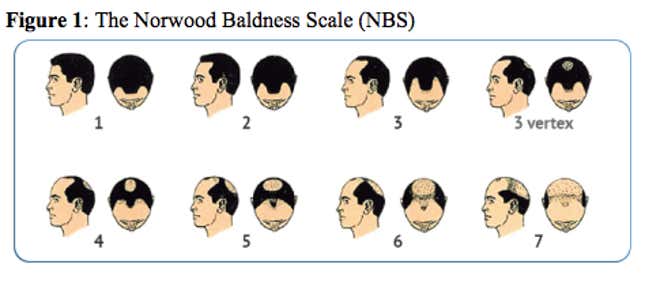Let’s say a man who’s bald as bowling ball, à la Bruce Willis today, has the opportunity to re-grow those locks so as to resemble a more luscious-locked Willis from his Die Hard days, or an even floppier hairstyle, perhaps like that Willis sported in his Moonlighting era. How much would he pay for this opportunity? This is, quite literally, the question posed by three Appalachian State University economists in a preprint of a paper published online in January and appropriately titled “Willingness Toupee.”
The academics used the Norwood Baldness Scale to evaluate baldness, and noted that contemporary Bruce Willis is a 7, Die Hard Bruce Williams is 3, and Moonlighting Bruce Willis counts as 2. Prince William today, in case you’re wondering, is a 4.

The study asked 151 balding men how much they would be willing to pay to permanently change their baldness. Each man self-evaluated their level of baldness, and then was presented with three potential stages of higher-high-growth from the baldness scale (so a 5 might be offered 1, 3, and 4 as potential hair scenarios, for example), and a randomly assigned price of $500, $5,000, $10,000, $25,000, or $50,000. The statistical model found that men would pay between $5,300-$5,800 to permanently increase their hair coverage by one level on the scale, e.g. to go from a 7 to a 6. In total, then, men were willing to pay more than $37,000 to go from totally bald to a full head of hair.
The study, note the authors, was the first of its kind; previously, there was “not one follicle of empirical evidence,” on the subject, they write. A few further findings from their paper: 26% of the male participants brush their hair forward to hide their bald patch (“very presidential,” they note), while 23% wear hats as cover-up, and 36% have tried a comb-over. “While the comb-over is clearly irrational, balding men behave rationally in our hypothetical markets,” they write.
In other words, while balding might seem trivial to some, it’s a perfectly suitable topic for a serious economics paper. That said, the researchers are self-aware enough to end the analysis with a lighthearted conclusion: Or, as they put it, the study was “business in the front, party in the back.”
